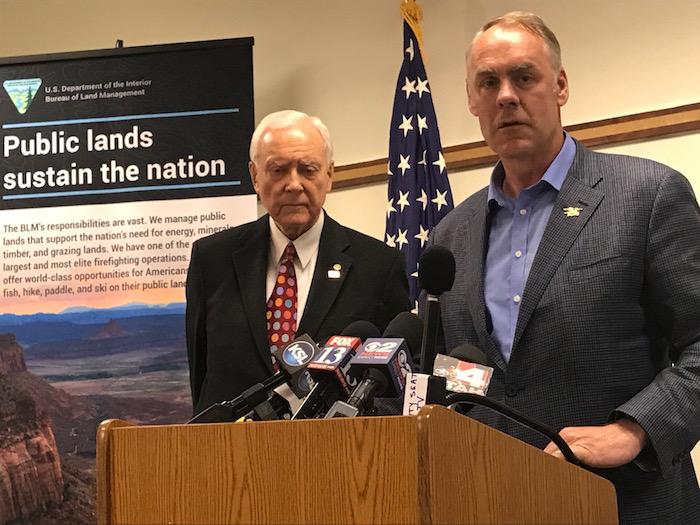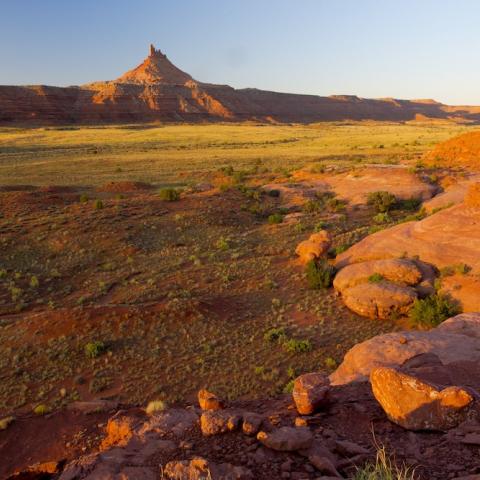
Interior Secretary Ryan Zinke, flanked by U.S. Sen. Orrin Hatch, arrived in Salt Lake on Sunday to begin a tour of Bears Ears and Grand Staircase-Escalante national monuments/Kurt Repanshek
Flanked by banners promoting public lands and how they "sustain the nation," Interior Secretary Ryan Zinke arrived in Utah on Sunday to begin his review of national monuments established over the past two decades with a promise not to recommend the abolishment of any monument to President Trump. The secretary did not, however, promise not to recommend a reduction in the size of any monument.
"The first monument was Devils Tower, 1,200 acres. The last administration had some monuments that are tens of millions of acres offshore," the secretary told a press gathering in the Utah state Bureau of Land Management Office in Salt Lake City. "And so it's a review. What am I doing to review? I'm looking at making sure we follow the law, what the Antiquities Act was intended to do. Talking to all parties, and giving a perspective of making sure that Utah and the stakeholders have a voice."
Outside the BLM building, several hundred protesters had gathered under the warm afternoon sun to show their support for both Bears Ears National Monument, which President Obama designated in the waning days of his administration, and Grand Staircase-Escalante National Monument, which President Clinton established in 1996. Both are managed by the BLM.
"Hands Off Our Public Lands," said some placards waved at passing vehicles on 200 South and 440 West, while others stated that "Utah Stands With Bears Ears" and "Utahns Say Save Grand Staircase."

Several hundred protesters turned out Sunday in Salt Lake City to urge Interior Secretary Zinke not to alter national monuments in Utah/Kurt Repanshek
The secretary's arrival in Utah put in motion a review that President Trump demanded via executive order on April 26. In signing the order, the Republican called his predecessors' use of the Antiquities Act to create national monuments an "egregious abuse of federal power." Secretary Zinke added Sunday that Westerners don't consider land-management agencies to be good stewards, singling out the U.S. Forest Service for how it handles stands of timber struggling with disease and prone to wildfires.
The unprecedented move to order Secretary Zinke to review nearly 30 national monuments to see whether they were carefully created under the guidelines of the Antiquities Act, which calls for the smallest possible monument in acreage to provide the necessary protection of historic, prehistoric, and scientific settings, accelerated protests by conservationists, non-governmental organizations, tribes, and corporations tied to the outdoors.
Over the next four days, the Interior secretary planned to fly over both Bears Ears and Grand Staircase, ride a horse through the landscape, and spend time hiking.
"I like going to the front line and seeing it," said Secretary Zinke, alluding to his military background.
But the review has raised great concerns from coast to coast, as it includes Katahdin Woods and Waters National Monument in Maine, where the Trump administration questions whether proper public input was received and considered by the Obama administration. That monument was created not out of federal lands, but rather private property donated to the government so it could be included within the National Park System. And during an appearance before the House Natural Resources Committee, Lucas St. Clair, whose family donated nearly 90,000 acres for the monument, testified that there was widespread support in Maine for it.
"The national park proposal gained support from important regional business and civic groups including the Katahdin Area Chamber of Commerce, the Katahdin Rotary Club, the Greater Houlton Chamber of Commerce, the Bangor City Council and the Maine Innkeepers Association," Mr. St. Clair testified last week. "More than 200 Maine businesses in the Katahdin, Houlton, Presque Isle, Bangor and Acadia regions endorsed the park proposal.
"In April 2015, a Critical Insights poll showed that 67 percent of residents of Maine’s 2nd Congressional district (northern, western and eastern Maine) supported the proposed national park unit," he added. "In November 2015, advocates delivered more than 13,000 signatures in support of the proposed park unit from residents of 371 Maine towns and 50 states to Maine’s congressional delegation."
That sort of turnout in Maine, and polling that suggests Westerners, even in Utah, support national monuments, has raised the appearance that politics more than stewardship is driving Secretary Zinke's review. While former Interior Secretary Sally Jewell spent four days in Utah last summer exploring the landscape of Bears Ears and talking to local community leaders and affected tribes, her successor isn't sure she didn't hear what she wanted to hear while disregarding opponents' views.
Secretary Zinke, who spent 90 minutes meeting with the Bears Ears Inter-Tribal Coalition before appearing before reporters representing both Utah news outlets as well as the New York Times, the Washington Post, NPR and other national outlets, never said what options he could pursue after his four days in the state. He had been lobbied earlier this year by Utah's congressional delegation and governor to recommend the abolishment of the Bears Ears National Monument, and the state legislature sent a resolution to President Trump with that same demand.
Rather, he reiterated the message he made on April 26 in Washington, that local stakeholders should have a voice when it comes to considering a landscape for national monument status. Asked how he would balance the voices of area stakeholders against those from the rest of the country, for public lands belong to all Americans, Secretary Zinke didn't offer specifics.
"Does a citizen from Massachusetts have any more standing from a citizen in Montana when it comes to our public lands? No. But everyone should have a voice, and a lot of what I face as secretary of Interior, there's a lot of anger out there. There's a lot of mistrust out there. There's a lot of mistrust directed at what I get concerned about, either the BLM or the Park Service or the Fish and Wildlife Service, that we're not capable of being great stewards of our lands. And I think we should collaborate with local communities, we should be invested in local communities ... I think being reflective of a local community is important, at least giving everyone a voice.
"The tribes feel like they haven't had a voice. But you're right, our public lands are for us. The public lands belong to all Americans, and all of us our stakeholders, and all of us should have a voice," he added.
U.S. Sen. Orrin Hatch, R-Utah, introduced the secretary to the media. After Mr. Zinke concluded his appearance, the senator said his hope tied to the secretary's visit was simply that local viewpoints gain better respect.
"I'm hopeful that we can bring people together rather than have them split apart," he said. "There's a lot of feeling on all sides of these issues, and I'm not locked in to anything. I'd just like to see our people come together and be treated fairly. We've had some pretty roughshod treatment from the federal government in the years, and it's hard to get over that."
When pressed to explain how the management guidelines placed on the Bears Ears differ from those proposed for the area by U.S. Reps. Rob Bishop and Jason Chaffetz, both Utah Republicans, in their Public Lands Initiative that went nowhere, Senator Hatch maintained that "the Indians, they don't fully understand that a lot of the things that they currently take for granted on those lands, they won't be able to do if it's made clearly into a monument or a wilderness."
When pressed, however, the senator could not cite a single example of what bans would be placed on tribes from using the national monument, saying "that would take too much time."
While the Bears Ears Inter-Tribal Coalition, which has the support of 30 Native American tribes, urged President Obama to designate Bears Ears after growing frustrated with what they felt was a lack of respect from Reps. Bishop and Chaffetz, Sen. Hatch contended Sunday that Native Americans "are manipulated sometimes by people. You've got to be really fair, and you've got to watch what's being done. But I'm going to make sure that they (the tribes) have their say and that the people in the area have their say."



 Support Essential Coverage of Essential Places
Support Essential Coverage of Essential Places







Comments
Jim L.--
As Kurt noted in the article, most of these large newer National Monuments came from BLM land, and are still managed by BLM, and their service & maintenence is covered by the BLM budget, just as it was before the proclamation/designation. The designations simply don't have an impact on the NPS budget: not as line-items for operations and not even in national support programs for things such as natural resoruce monitoring (BLM does their own thing, and any joint work will almost certainly involve BLM bringing their resources to the collaboration). The monument designation slightly changes how BLM manages these areas, primarily shifting the balance from "productive uses" toward "unimpaired for the enjoyment of future generations". While pothunting/graverobbing/archeological looting is already illegal on public lands, I believe that National Monument designation makes such actions covered by other laws that are easier to enforce, but that's not my expertise, and that's minor relative to the shift in BLM management emphases.
The exception that proves the rule is Katahdin Woods & Waters NM in Maine, which is NPS. Part of the condition for the government accepting the land donation was a financial donation sufficient to cover the costs of establishment, and agreement to spearhead fundraising to establish an endowment so that ongoing operations of that National Monument will be covered by the endowment income, not appropriated funds. So again, the bottom line is that the Monument designation simply does not take away funding that could have been used at other NPS National Parks & Monuments.